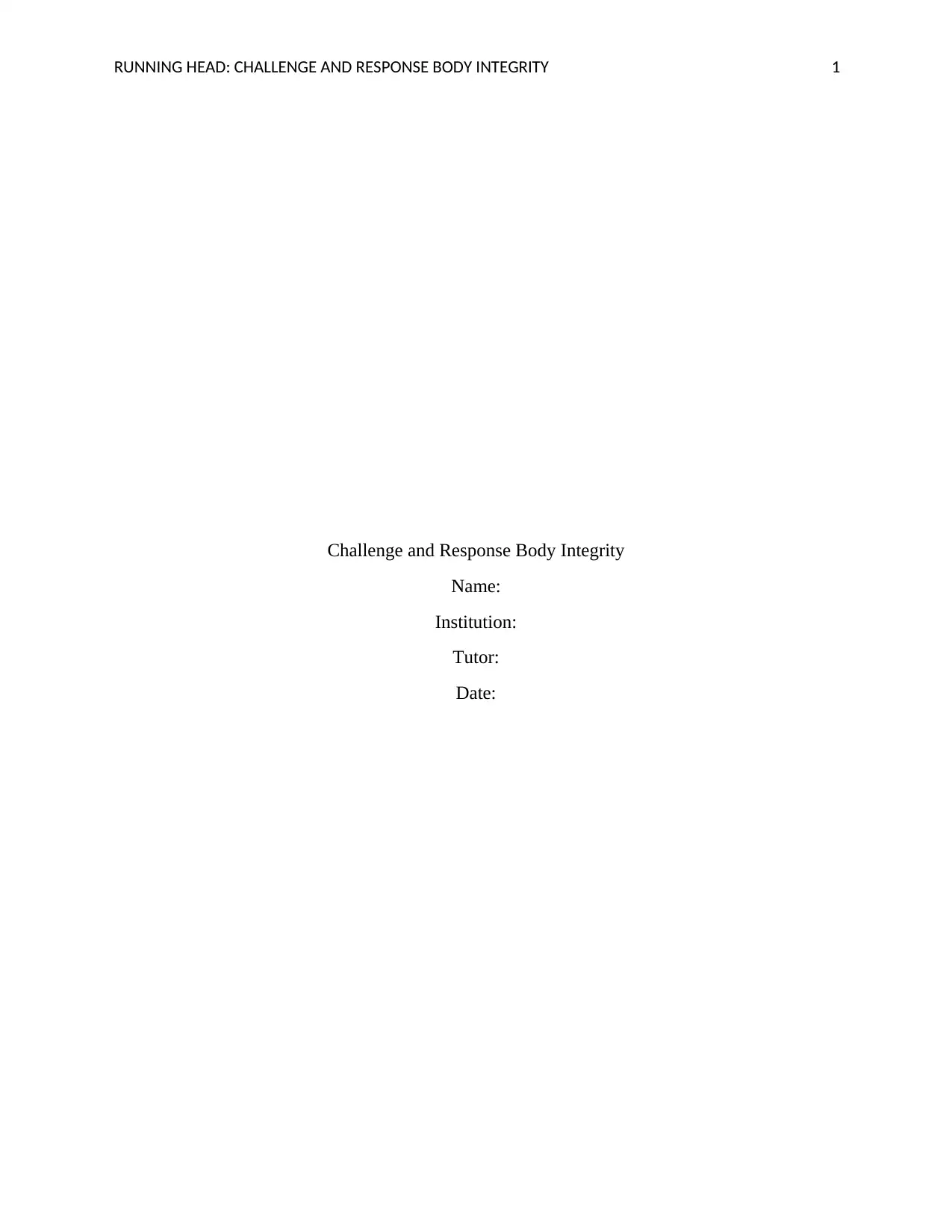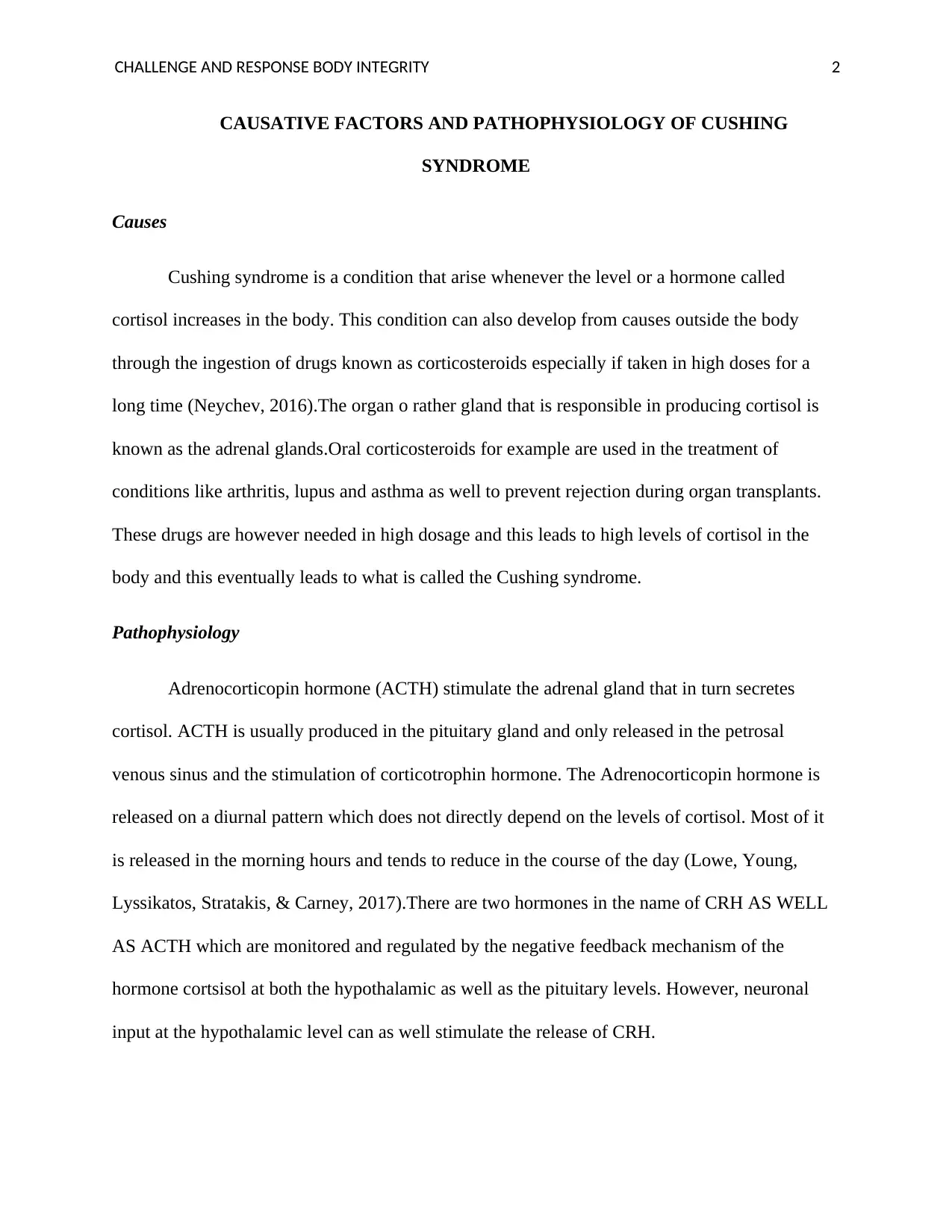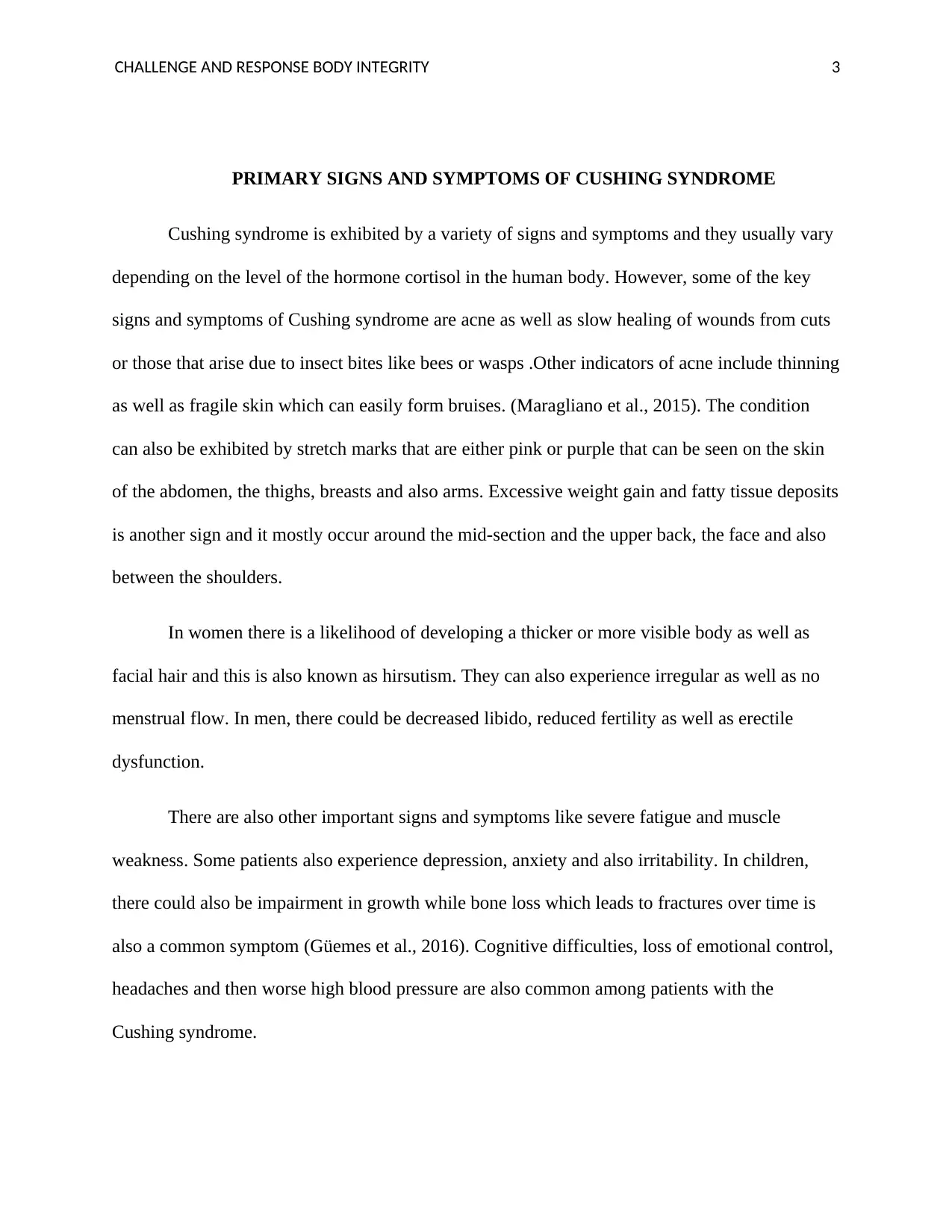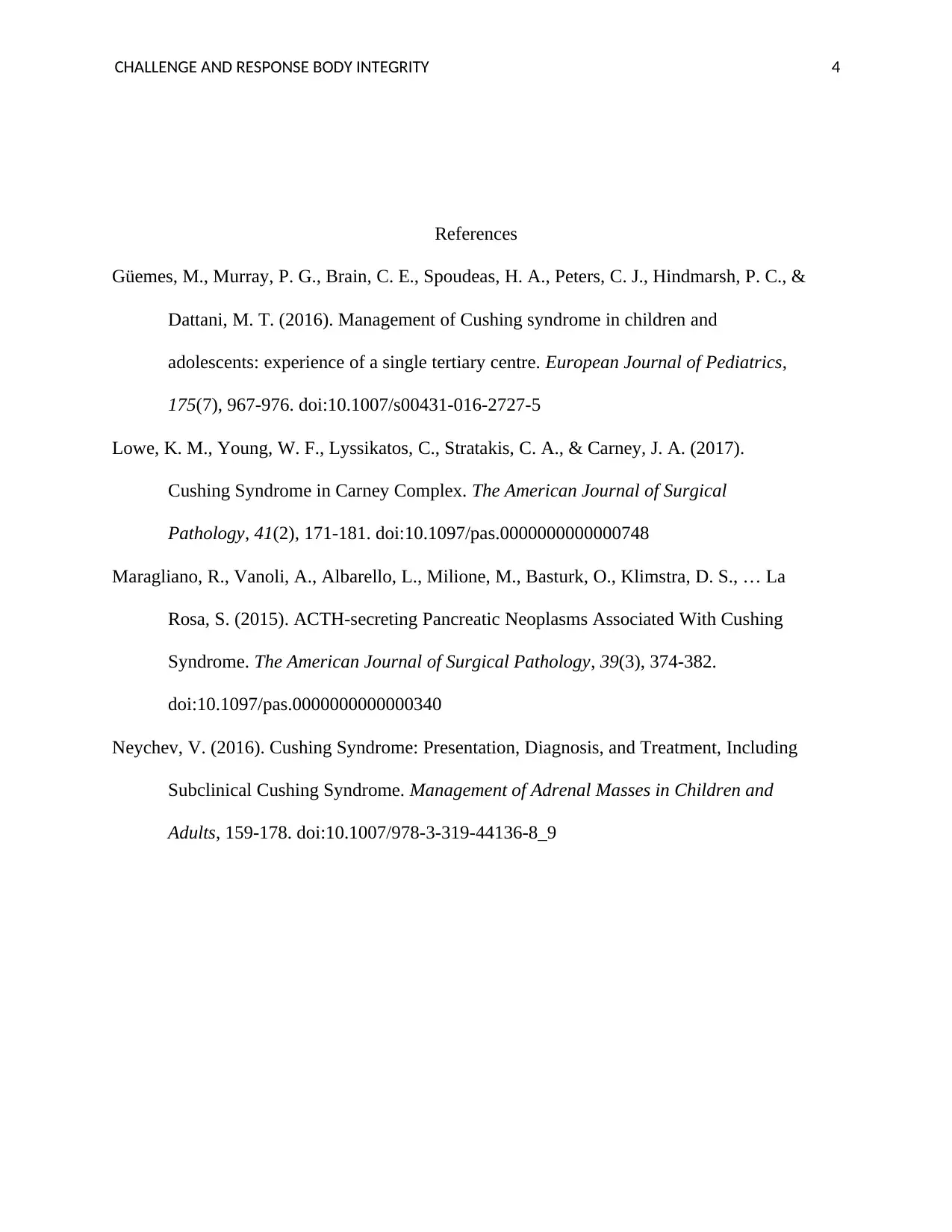NUR241 - Analyzing Sara Haines' Cushing Syndrome: A Case Study
VerifiedAdded on 2023/06/09
|4
|825
|332
Case Study
AI Summary
This assignment presents a case study of Sara Haines, a 38-year-old woman presenting with symptoms indicative of Cushing syndrome. The analysis covers the causative factors and pathophysiology of Cushing syndrome, highlighting the role of cortisol and the adrenocorticotropic hormone (ACTH). It details the primary signs and symptoms exhibited by Sara, including weight gain, facial hair growth, menstrual abnormalities, and fatigue. The document further discusses potential causes, such as corticosteroid use and adrenal gland dysfunction. References to relevant research articles are provided, supporting the information presented in the case study analysis. Desklib provides solved assignments and study tools for students.

RUNNING HEAD: CHALLENGE AND RESPONSE BODY INTEGRITY 1
Challenge and Response Body Integrity
Name:
Institution:
Tutor:
Date:
Challenge and Response Body Integrity
Name:
Institution:
Tutor:
Date:
Paraphrase This Document
Need a fresh take? Get an instant paraphrase of this document with our AI Paraphraser

CHALLENGE AND RESPONSE BODY INTEGRITY 2
CAUSATIVE FACTORS AND PATHOPHYSIOLOGY OF CUSHING
SYNDROME
Causes
Cushing syndrome is a condition that arise whenever the level or a hormone called
cortisol increases in the body. This condition can also develop from causes outside the body
through the ingestion of drugs known as corticosteroids especially if taken in high doses for a
long time (Neychev, 2016).The organ o rather gland that is responsible in producing cortisol is
known as the adrenal glands.Oral corticosteroids for example are used in the treatment of
conditions like arthritis, lupus and asthma as well to prevent rejection during organ transplants.
These drugs are however needed in high dosage and this leads to high levels of cortisol in the
body and this eventually leads to what is called the Cushing syndrome.
Pathophysiology
Adrenocorticopin hormone (ACTH) stimulate the adrenal gland that in turn secretes
cortisol. ACTH is usually produced in the pituitary gland and only released in the petrosal
venous sinus and the stimulation of corticotrophin hormone. The Adrenocorticopin hormone is
released on a diurnal pattern which does not directly depend on the levels of cortisol. Most of it
is released in the morning hours and tends to reduce in the course of the day (Lowe, Young,
Lyssikatos, Stratakis, & Carney, 2017).There are two hormones in the name of CRH AS WELL
AS ACTH which are monitored and regulated by the negative feedback mechanism of the
hormone cortsisol at both the hypothalamic as well as the pituitary levels. However, neuronal
input at the hypothalamic level can as well stimulate the release of CRH.
CAUSATIVE FACTORS AND PATHOPHYSIOLOGY OF CUSHING
SYNDROME
Causes
Cushing syndrome is a condition that arise whenever the level or a hormone called
cortisol increases in the body. This condition can also develop from causes outside the body
through the ingestion of drugs known as corticosteroids especially if taken in high doses for a
long time (Neychev, 2016).The organ o rather gland that is responsible in producing cortisol is
known as the adrenal glands.Oral corticosteroids for example are used in the treatment of
conditions like arthritis, lupus and asthma as well to prevent rejection during organ transplants.
These drugs are however needed in high dosage and this leads to high levels of cortisol in the
body and this eventually leads to what is called the Cushing syndrome.
Pathophysiology
Adrenocorticopin hormone (ACTH) stimulate the adrenal gland that in turn secretes
cortisol. ACTH is usually produced in the pituitary gland and only released in the petrosal
venous sinus and the stimulation of corticotrophin hormone. The Adrenocorticopin hormone is
released on a diurnal pattern which does not directly depend on the levels of cortisol. Most of it
is released in the morning hours and tends to reduce in the course of the day (Lowe, Young,
Lyssikatos, Stratakis, & Carney, 2017).There are two hormones in the name of CRH AS WELL
AS ACTH which are monitored and regulated by the negative feedback mechanism of the
hormone cortsisol at both the hypothalamic as well as the pituitary levels. However, neuronal
input at the hypothalamic level can as well stimulate the release of CRH.

CHALLENGE AND RESPONSE BODY INTEGRITY 3
PRIMARY SIGNS AND SYMPTOMS OF CUSHING SYNDROME
Cushing syndrome is exhibited by a variety of signs and symptoms and they usually vary
depending on the level of the hormone cortisol in the human body. However, some of the key
signs and symptoms of Cushing syndrome are acne as well as slow healing of wounds from cuts
or those that arise due to insect bites like bees or wasps .Other indicators of acne include thinning
as well as fragile skin which can easily form bruises. (Maragliano et al., 2015). The condition
can also be exhibited by stretch marks that are either pink or purple that can be seen on the skin
of the abdomen, the thighs, breasts and also arms. Excessive weight gain and fatty tissue deposits
is another sign and it mostly occur around the mid-section and the upper back, the face and also
between the shoulders.
In women there is a likelihood of developing a thicker or more visible body as well as
facial hair and this is also known as hirsutism. They can also experience irregular as well as no
menstrual flow. In men, there could be decreased libido, reduced fertility as well as erectile
dysfunction.
There are also other important signs and symptoms like severe fatigue and muscle
weakness. Some patients also experience depression, anxiety and also irritability. In children,
there could also be impairment in growth while bone loss which leads to fractures over time is
also a common symptom (Güemes et al., 2016). Cognitive difficulties, loss of emotional control,
headaches and then worse high blood pressure are also common among patients with the
Cushing syndrome.
PRIMARY SIGNS AND SYMPTOMS OF CUSHING SYNDROME
Cushing syndrome is exhibited by a variety of signs and symptoms and they usually vary
depending on the level of the hormone cortisol in the human body. However, some of the key
signs and symptoms of Cushing syndrome are acne as well as slow healing of wounds from cuts
or those that arise due to insect bites like bees or wasps .Other indicators of acne include thinning
as well as fragile skin which can easily form bruises. (Maragliano et al., 2015). The condition
can also be exhibited by stretch marks that are either pink or purple that can be seen on the skin
of the abdomen, the thighs, breasts and also arms. Excessive weight gain and fatty tissue deposits
is another sign and it mostly occur around the mid-section and the upper back, the face and also
between the shoulders.
In women there is a likelihood of developing a thicker or more visible body as well as
facial hair and this is also known as hirsutism. They can also experience irregular as well as no
menstrual flow. In men, there could be decreased libido, reduced fertility as well as erectile
dysfunction.
There are also other important signs and symptoms like severe fatigue and muscle
weakness. Some patients also experience depression, anxiety and also irritability. In children,
there could also be impairment in growth while bone loss which leads to fractures over time is
also a common symptom (Güemes et al., 2016). Cognitive difficulties, loss of emotional control,
headaches and then worse high blood pressure are also common among patients with the
Cushing syndrome.
⊘ This is a preview!⊘
Do you want full access?
Subscribe today to unlock all pages.

Trusted by 1+ million students worldwide

CHALLENGE AND RESPONSE BODY INTEGRITY 4
References
Güemes, M., Murray, P. G., Brain, C. E., Spoudeas, H. A., Peters, C. J., Hindmarsh, P. C., &
Dattani, M. T. (2016). Management of Cushing syndrome in children and
adolescents: experience of a single tertiary centre. European Journal of Pediatrics,
175(7), 967-976. doi:10.1007/s00431-016-2727-5
Lowe, K. M., Young, W. F., Lyssikatos, C., Stratakis, C. A., & Carney, J. A. (2017).
Cushing Syndrome in Carney Complex. The American Journal of Surgical
Pathology, 41(2), 171-181. doi:10.1097/pas.0000000000000748
Maragliano, R., Vanoli, A., Albarello, L., Milione, M., Basturk, O., Klimstra, D. S., … La
Rosa, S. (2015). ACTH-secreting Pancreatic Neoplasms Associated With Cushing
Syndrome. The American Journal of Surgical Pathology, 39(3), 374-382.
doi:10.1097/pas.0000000000000340
Neychev, V. (2016). Cushing Syndrome: Presentation, Diagnosis, and Treatment, Including
Subclinical Cushing Syndrome. Management of Adrenal Masses in Children and
Adults, 159-178. doi:10.1007/978-3-319-44136-8_9
References
Güemes, M., Murray, P. G., Brain, C. E., Spoudeas, H. A., Peters, C. J., Hindmarsh, P. C., &
Dattani, M. T. (2016). Management of Cushing syndrome in children and
adolescents: experience of a single tertiary centre. European Journal of Pediatrics,
175(7), 967-976. doi:10.1007/s00431-016-2727-5
Lowe, K. M., Young, W. F., Lyssikatos, C., Stratakis, C. A., & Carney, J. A. (2017).
Cushing Syndrome in Carney Complex. The American Journal of Surgical
Pathology, 41(2), 171-181. doi:10.1097/pas.0000000000000748
Maragliano, R., Vanoli, A., Albarello, L., Milione, M., Basturk, O., Klimstra, D. S., … La
Rosa, S. (2015). ACTH-secreting Pancreatic Neoplasms Associated With Cushing
Syndrome. The American Journal of Surgical Pathology, 39(3), 374-382.
doi:10.1097/pas.0000000000000340
Neychev, V. (2016). Cushing Syndrome: Presentation, Diagnosis, and Treatment, Including
Subclinical Cushing Syndrome. Management of Adrenal Masses in Children and
Adults, 159-178. doi:10.1007/978-3-319-44136-8_9
1 out of 4
Related Documents
Your All-in-One AI-Powered Toolkit for Academic Success.
+13062052269
info@desklib.com
Available 24*7 on WhatsApp / Email
![[object Object]](/_next/static/media/star-bottom.7253800d.svg)
Unlock your academic potential
Copyright © 2020–2025 A2Z Services. All Rights Reserved. Developed and managed by ZUCOL.





